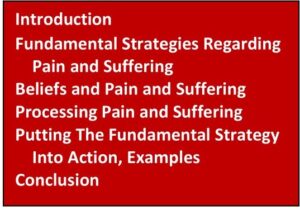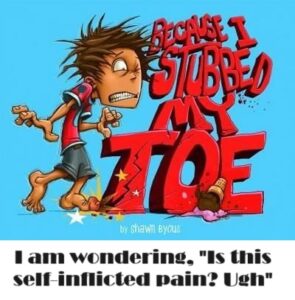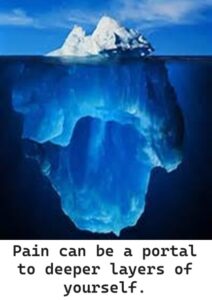Pain and Suffering Part II, Causes and Responses
Introduction
In a previous Letter we defined pain as a specific, localized, sensation in our body. It is a negative, unwanted feeling. It is a signal from our body that something is wrong, that there is something we need to pay attention to. Suffering is a complex generalized experience characterized by some or all of—discomfort, angst, anguish, agony, and torment. Grief, sorrow, sadness, helplessness, and unhappiness can also be aspects of a person’s suffering, and pain is always present in suffering because the feelings of suffering are full of pain. In previous Letters we offered effective strategies for living as ways to avoid and minimize pain and suffering. Most of what we say refers both to pain and suffering but sometimes we will just refer to pain.
Now let’s turn our attention to the causes of pain and suffering and how to respond to them when they come our way. Understanding the causes will help us prevent pain and suffering and help us develop some ways of responding to them. Responding is what we do the moment after experiencing pain and suffering and responding effectively is an important skill to learn. This has profound implications for our wellbeing.
Point of Empowerment: As we learn to identify and resolve the causes of our pain and suffering our life can change dramatically.
In the first Letter on pain and suffering we introduced a chart identifying the type and source of pain and suffering and classifying it as avoidable or unavoidable. This is a useful visual that helps us organize ideas.
Types And Aspects Of Pain And Suffering. Chart One
| Type Source | Unavoidable | Avoidable |
| Physical Source: Internal | ||
| Source: External | ||
| Emotional Source: Internal | ||
| Source: External | ||
| Mental Source: Internal | ||
| Source: External | ||
| Spiritual Source: Internal | ||
| Source: External |
From the chart we can see that some pain and suffering is avoidable. One type of avoidable pain and suffering is self-inflicted pain and suffering. Self-inflicted pain and suffering may be hard to see and to accept but the idea that some of our pain and suffering is self-inflicted is empowering as we can learn to avoid doing this to ourselves.
Point of Empowerment: A layer of self-inflicted pain and suffering is always caused by a faulty response to pain and suffering.
FUNDAMENTAL STRATEGIES REGARDING PAIN AND SUFFERING
BELIEFS AND PAIN AND SUFFERING
Before moving onto a process for dealing with pain and suffering, let’s consider some useful introductory ideas about beliefs. There are three categories of belief—core, intermediate, and operating. Core beliefs are foundational and fundamental beliefs about ourselves and the world. Intermediate beliefs are logical extensions of core beliefs that we apply to ourself in a particular situation. And operating beliefs are beliefs that we use in our everyday life that motivate our actions. Beliefs give rise to thoughts and feelings, that give rise to emotions (the combination of thought and feelings). Emotions trigger actions.
Our beliefs can cause us physical, emotional, mental, or spiritual pain no matter what the source of the pain is or if it is avoidable or unavoidable. Our beliefs can bring on (initiate) pain or intensify the experience of pain that we are having by coloring our response.
PROCESSING PAIN AND SUFFERING
Here is the outline of a process for responding to the experience of pain and suffering and to transform them. This process includes finding and resolving the cause of a particular pain so we don’t have to experience this pain again. To apply these concepts effectively takes a lot of self-exploration, understanding, and practice, so what is presented here is essentially an introduction. Let’s begin.
begin.
- First, respond to pain and suffering by relaxing into them, relaxing physically, emotionally, mentally, and spiritually. Do not fight or resist it but accept that this is the reality of this present moment and cannot be different or avoided. Try not to tense up physically or erect defense mechanisms against the pain or suffering if possible.
- Name the pain and suffering and describe it in detail.
- Identify the type and aspects of the pain. Use chart one.
- Find and resolve the cause of the pain and suffering.
- Identify and state your beliefs about the cause and your response to the pain and suffering.
- Change disempowering/dysfunctional beliefs.
- Identify, explore, process, and eliminate self-inflicted pain and suffering.
- Use effective strategies for living to deal with pain and suffering. (See the Letters about Effective Strategies. October and December 2023)
Here is a flow chart listing the steps of this process. Filling in the chart could be helpful.
Processing Pain and Suffering. Chart Two
| Description of a specific pain | Type of pain: Physical, Emotional, Mental, Spiritual | Cause | Disempowering Belief | Empowering Belief | Effective strategy for living |
Point of Empowerment: The causes of and our response to pain and suffering are complex. Learning to deal with them is part of the art of living.
PUTTING THE FUNDAMENTAL STRATEGY INTO ACTION, EXAMPLES
Cause: Event—My son left his coat at school despite my request that he bring it home. He does not take care of or appreciate his things. I feel extremely frustrated and angry. These feelings wake me up at night. I can’t sleep.
The pain: emotional—frustration and anger; external and unavoidable—caused by an event; internal and avoidable—caused by my emotional reaction to the event.
Core belief: Children should value and appreciate what their parents buy for them. Children should cooperate with reasonable parental requests.
Dysfunctional Core belief: Children should always value and appreciate what their parents buy for them and obey their parents’ wishes. Also, if my son does not value his things he does not value me since I bought them. These beliefs intensify the emotional responses causing more frustration and anger than appropriate or necessary. This intensification is self-inflicted pain.
Intermediate belief: Parents should talk to their children about the importance of valuing and appreciation and follow up with instructive consequences if necessary. Parents should teach about valuing and appreciation by setting a good example, by being a good role model. Parents should work with their children to obtain cooperation with reasonable requests rather than demanding blind obedience.
Dysfunctional Intermediate belief: Children should be taught appreciation by lecture, admonishment, or punishment if they do not show appreciation. Compliance with requests should be demanded with punishment for lack of cooperation. My son is unappreciative of my efforts therefore he does not value me. My frustration and anger are further intensified by dysfunctional intermediate beliefs. This is self-inflicted pain.
Operating belief leading to action: I should do something to teach valuing and seek cooperation.
Dysfunctional operating belief leading to action: I will scold, lecture, and punish my son until I get the right attitudes and obedience from him.
Evaluation of strategy: This is an overreaction that will cause excessive pain for the son and for the parent as the son will resist, rebel, (silently if not openly), and will not learn anything that the parent desires to teach. The natural feeling of frustration is followed by intensified and unnecessary anger and the desire to punish.
Effective strategy for living: Identify the excessive pain that is present. See if the chosen parenting techniques get the desired results. Research useful parenting techniques or talk with other parents about what works for them. Put the new strategies that you have learned into action and observe the consequences. Examine and change the beliefs that are not getting you what you want.
Example
Cause: Event—I have been reflecting on the pain and suffering in my life.
Core belief: Life brings us pain and suffering but with strength and resilience I can respond in ways that minimize this pain and suffering.
Intermediate belief: I am strong and resilient.
Operating belief leading to action: My friend rejected me but being strong and resilient I experience the pain of this rejection, reflected on the relationship with my friend, release the pain, and move on.
Effective strategy for living: I feel my pain. I utilize my inner resources of strength and resilience, release the pain, determine and resolve the causes of the pain, put what I have learned into practice, and move on. Also, whenever something happens that does not seem right I ask myself, “What must I believe that creates or influences this?”
Practice: Discover your beliefs about pain and suffering in general and about the pain and suffering you are experiencing in a present moment. State, “These are my beliefs about pain and suffering. I believe . . .” and fill in the blank writing down everything that you think. Or state, “I am experiencing pain at this moment. My beliefs about this pain are . . .” and fill in the blank writing down what you think. Work with beliefs that seem to prevent you from coping with this pain and the beliefs that increase the intensity of a painful feeling that you are experiencing.
present moment. State, “These are my beliefs about pain and suffering. I believe . . .” and fill in the blank writing down everything that you think. Or state, “I am experiencing pain at this moment. My beliefs about this pain are . . .” and fill in the blank writing down what you think. Work with beliefs that seem to prevent you from coping with this pain and the beliefs that increase the intensity of a painful feeling that you are experiencing.
Practice: Develop personality traits, like strength, resilience, and courage, that will enable you to respond more effectively to the pain and suffering in your life.
Practice: Continually revise the strategies that are not getting you what you want and develop new effective strategies for living.
CONCLUSION
In this Letter we explored various aspects of pain and suffering. We described and applied an extremely useful process for coping with and transforming our pain and suffering. Ultimately we can eliminate some of our pain and suffering by eliminating the cause, especially the causes of self-inflicted pain. In the next Letter we will give additional examples to see this process at work.
